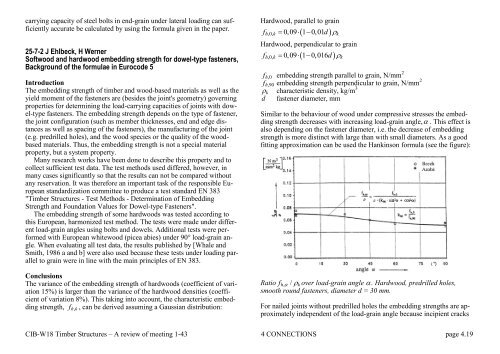Download pdf - CIB-W18
Download pdf - CIB-W18
Download pdf - CIB-W18
- TAGS
- download
- cib-w18.com
Create successful ePaper yourself
Turn your PDF publications into a flip-book with our unique Google optimized e-Paper software.
carrying capacity of steel bolts in end-grain under lateral loading can sufficiently<br />
accurate be calculated by using the formula given in the paper.<br />
25-7-2 J Ehlbeck, H Werner<br />
Softwood and hardwood embedding strength for dowel-type fasteners,<br />
Background of the formulae in Eurocode 5<br />
Introduction<br />
The embedding strength of timber and wood-based materials as well as the<br />
yield moment of the fasteners are (besides the joint's geometry) governing<br />
properties for determining the load-carrying capacities of joints with dowel-type<br />
fasteners. The embedding strength depends on the type of fastener,<br />
the joint configuration (such as member thicknesses, end and edge distances<br />
as well as spacing of the fasteners), the manufacturing of the joint<br />
(e.g. predrilled holes), and the wood species or the quality of the woodbased<br />
materials. Thus, the embedding strength is not a special material<br />
property, but a system property.<br />
Many research works have been done to describe this property and to<br />
collect sufficient test data. The test methods used differed, however, in<br />
many cases significantly so that the results can not be compared without<br />
any reservation. It was therefore an important task of the responsible European<br />
standardization committee to produce a test standard EN 383<br />
"Timber Structures - Test Methods - Determination of Embedding<br />
Strength and Foundation Values for Dowel-type Fasteners".<br />
The embedding strength of some hardwoods was tested according to<br />
this European, harmonized test method. The tests were made under different<br />
load-grain angles using bolts and dowels. Additional tests were performed<br />
with European whitewood (picea abies) under 90° load-grain angle.<br />
When evaluating all test data, the results published by [Whale and<br />
Smith, 1986 a and b] were also used because these tests under loading parallel<br />
to grain were in line with the main principles of EN 383.<br />
Conclusions<br />
The variance of the embedding strength of hardwoods (coefficient of variation<br />
15%) is larger than the variance of the hardwood densities (coeffi-<br />
cient of variation 8%). This taking into account, the characteristic embed-<br />
f , can be derived assuming a Gaussian distribution:<br />
ding strength, hk ,<br />
Hardwood, parallel to grain<br />
� �<br />
f � 0,09 � 1� 0,01d<br />
�<br />
h,0, k k<br />
Hardwood, perpendicular to grain<br />
� �<br />
f � 0,09 � 1� 0,016d<br />
�<br />
h,0, k k<br />
f h,0<br />
embedding strength parallel to grain, N/mm 2<br />
f h,90<br />
embedding strength perpendicular to grain, N/mm 2<br />
� k characteristic density, kg/m 3<br />
d fastener diameter, mm<br />
Similar to the behaviour of wood under compressive stresses the embedding<br />
strength decreases with increasing load-grain angle,� . This effect is<br />
also depending on the fastener diameter, i.e. the decrease of embedding<br />
strength is more distinct with large than with small diameters. As a good<br />
fitting approximation can be used the Hankinson formula (see the figure):<br />
Ratio fh, � / �kover load-grain angle � � . Hardwood, predrilled holes,<br />
smooth round fasteners, diameter d = 30 mm.<br />
For nailed joints without predrilled holes the embedding strengths are approximately<br />
independent of the load-grain angle because incipient cracks<br />
<strong>CIB</strong>-<strong>W18</strong> Timber Structures – A review of meeting 1-43 4 CONNECTIONS page 4.19














